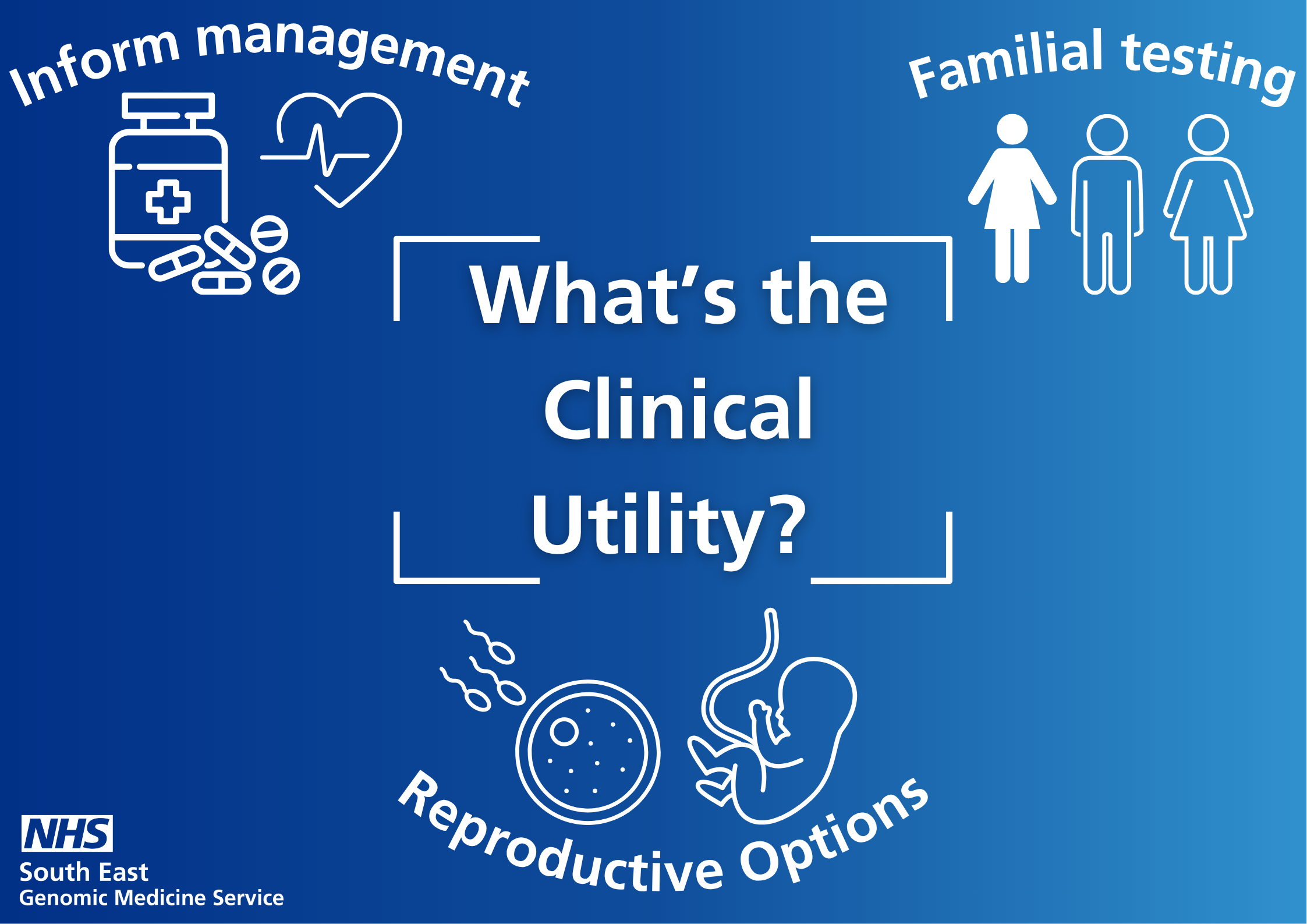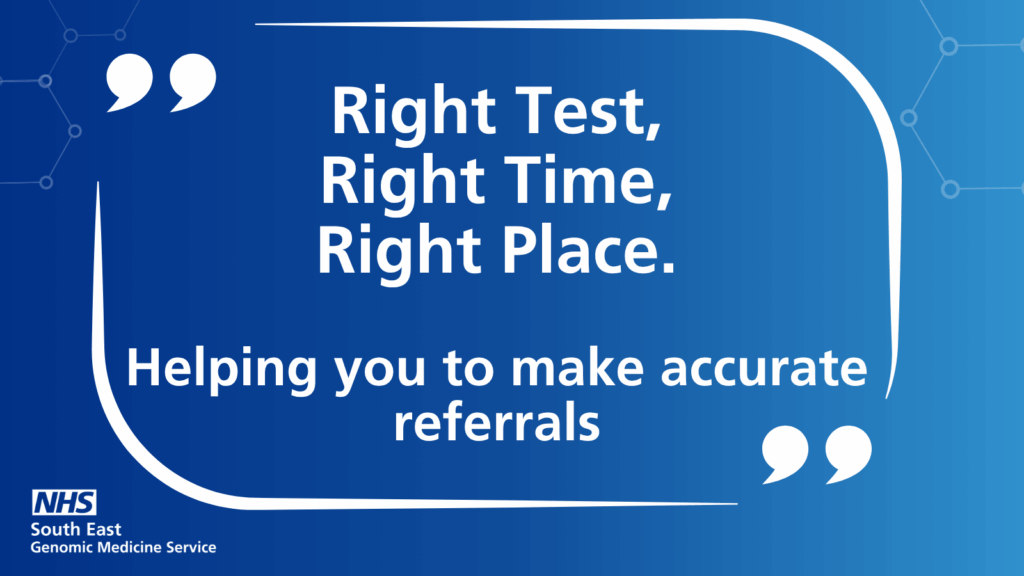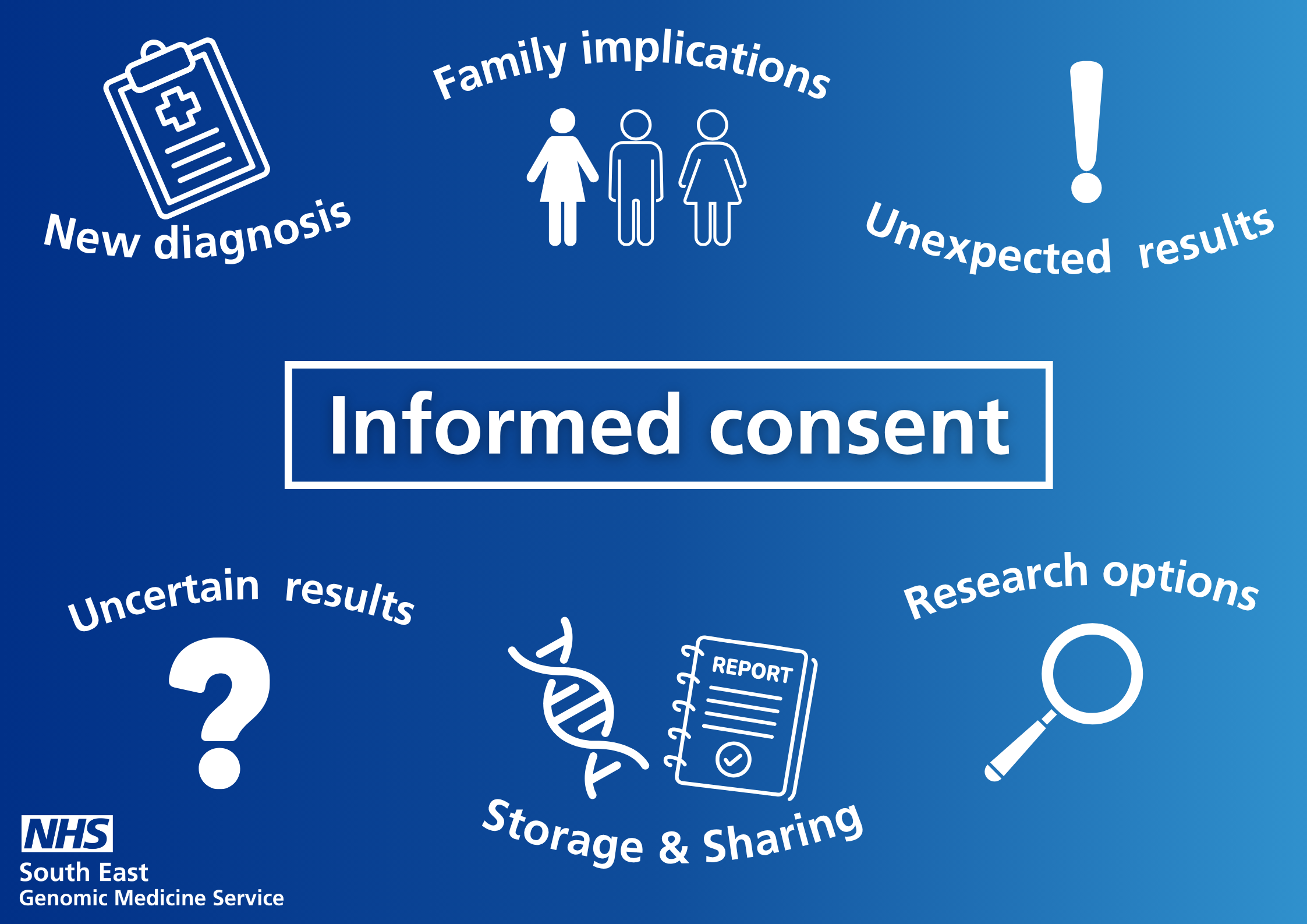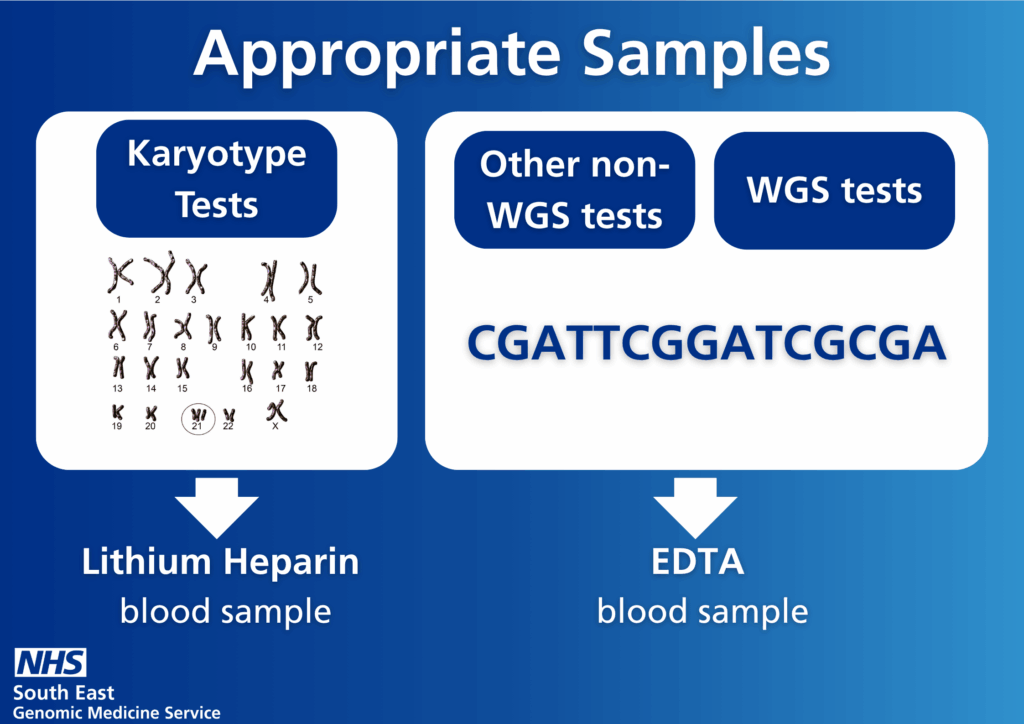How to order a Genomic Test
An outline of the process for requesting a Genomic Test for a Rare Disease, including inherited cancer predisposition syndromes.

Do you want to arrange a Rare Disease genomic test for your patient?
There are several points to consider when referring a patient for genomic testing. Following the steps below will help you to complete all of the necessary stages.
-
Determine if it is clinically useful for your patient to undergo genomic testing for Rare Disease

NHS resources are limited. It is important genomic testing is only offered when it is clinically useful to do so.
Genomic testing is clinically useful if…
- The result of the genomic test may influence treatment or screening decisions
- There are family members wishing to have predictive genetic testing to determine their future risk (this is not possible unless a causative genomic variant is detected in an affected family member)
- The patient or family members are interested in pursuing reproductive options to prevent future generations inheriting the condition. Reproductive options include testing a pregnancy, or undergoing Pre-Implantation Genetic Testing (PGT)- a special form of IVF in which embryos undergo genetic testing before being transferred into the womb.
Struggling to decide if a test is clinically useful? Watch video 1 in our Genomic Testing series.
-
Identify the most appropriate genomic test for your patient

The National Genomic Test Directory lists all of the genomic tests commissioned for use within the NHS. Each test has its own unique code (R code) which you will need to include on the Test Order Form.
It is important to ensure that your patient meets the eligibility criteria outlined in the test directory. You must state which criteria your patient meets on the Test Order Form.
The test directory also indicates which tests are Whole Genome Sequencing (WGS) tests. This is important as it influences which Test Order Form and Record of Discussion Form you will need to complete (see steps 3 & 4 for details).
Want some extra help navigating the National Genomic Test Directory? Watch video 2 in our Genomic Testing series.
You can also use our Order of Find a Test directory to select the most appropriate test for your patient. Search for a symptom and the directory will identify all of the relevant tests. The directory also lists the eligibility criteria and contains links to the relevant Test Order Form and Record of Discussion Form.
-
Take your patient’s consent for Genomic Testing

Before requesting a genomic test, you should ensure your patient fully understands the potential implications of the test for them and their family members. If your patient is a child, consent for genomic testing should be taken from their parents.
You should use a Record of Discussion form to discuss the potential outcomes of the test with the patient or family.
GeNotes has produced a useful resource to help you to understand how to complete a record of discussion form.
You need to know if your test is a WGS test or a non-WGS test as this determines which Record of Discussion form you will need to complete. This information can be found by searching for your test using our Order or Find a Test Directory. Step 2 above also provides further guidance on this.
The table below outlines which forms you will need complete and what to do with them.
Whole Genome Sequencing (WGS) Testing Non-Whole Genome Sequencing (WGS) Tests Which Record of Discussion form should I use? WGS Record of Discussion form
(see link below)Non-WGS Record of Discussion form
(see link below)How many copies of the Record of Discussion form should I complete?
Complete one WGS Record of Discussion form per family member providing a DNA sample.
If you are arranging a Trio test (sending DNA from a child and both parents), you need to complete three WGS Record of Discussion forms.
Complete one Record of Discussion form for the patient undergoing genomic testing.
What should I do with the completed Record of Discussion form?
Each completed WGS Record of discussion form should be emailed to the WGS team as they need the completed forms to activate testing.
Send completed WGS Record of Discussion forms to gstt.wgs@nhs.net (one email per referral)
Record of Discussion form does not need to need to be emailed to the laboratory.
It may be helpful to store a copy in the patient's notes and give them a copy for their records.
There are two different Record of Discussion forms:
Download our help QR code booklet to ensure you have links to all the necessary forms and information. You can print a tri-fold booklet or download an electronic version.
Genomics England have produced a range of patient resources to support clinicians discussing genomic testing with patients.
Visit our Patient Resources page to access more resources to support your patients.
-
Complete the relevant Test Order Form

Once you have taken the patient/family’s consent for genomic testing, you need to complete a Test Order form. The table below helps you to to decide which form to fill in and what to do with it.
Whole Genome Sequencing (WGS) Testing Non-Whole Genome Sequencing (WGS) Tests Which Test order form should I complete? Rare Disease WGS Test Request form
(see link below)
Non-WGS Test Request form
(see link below)
How many copies of the Test Order form should I complete?
Complete one Rare Disease WGS Test Request form per family.
If you are arranging a Trio test (sending DNA from a child and both parents), you only need to complete one test request form for the entire family.
Complete one copy of the Non-WGS Test Request form.
What should I do with the completed Test Order form?
The completed Test Order form should be emailed to the WGS team so they can activate testing.
Send completed WGS Test Request forms to gstt.wgs@nhs.net
(one email per referral)
The Non-WGS Test Request form does not need to need to be emailed to the laboratory.
Give the Test Request form to the patient to take to phlebotomy.
The patient sample needs to be sent to the laboratory with the Test Request form.
Do I need to send a form with the patient sample?
The sample must be sent to the laboratory with an accompanying form.
You can send the sample with a completed Non-WGS Test Request form.
Alternatively, you could send the sample with a print-out of the Rare Disease WGS Test Request form.
The sample must be sent to the laboratory with the completed Non-WGS Test Request form.
Download the Test Request form:
- For WGS tests: Rare Disease WGS Test Request form
- For non-WGS tests: Non-WGS Test Request form.
Key points to remember:
- Include the ‘R code‘ This is the reference number for the test you are ordering. It can be found using our Order or Find a Test Directory
- State which of the test eligibility criteria your patient meets. If you do not include this, your referral may be rejected. Eligibility criteria can be found using our Order or Find a Test Directory
- State why it is clinically useful for your patient to undergo genomic testing. There is more information about this in Step 1.
- Include your patient’s ethnicity on the Test Order form. This helps the scientists to interpret any genetic variants found.
- Consider adding a departmental group email address to the Test Order Form. Genomic reports can only be emailed to the address listed. Using a group email address reduces the risk of results being missed due to unplanned leave etc.
- If you are arranging a WGS test, select Human Phenotype Ontology (HPO) terms that describe your patient’s phenotype. HPO terms can be found on the Human Phenotype Ontology website. Include all HPO terms relevant to your patient even if they are unrelated to the reason you are ordering the test. Ideally WGS referrals should include 3-5 HPO terms. Scientists need a full understanding of your patient’s features to interpret any genetic variants found during testing.
GeNotes has produced a detailed guide about how to complete a test order form for whole genome sequencing.
The Genomics Education Programme explains the process of Requesting Whole Genome Sequencing in detail.
Download our WGS: 7 Steps for Success guide
Download our help QR code booklet to ensure you have links to all the necessary forms and information. You can print a tri-fold booklet or download an electronic version.
-
Send a sample

Most genomic tests require an EDTA blood sample (purple top)
Karyotype tests require a Lithium Heparin blood sample
Saliva samples can be sent if taking a blood sample is problematic
Formalin damages DNA so please send tissue samples in an alternative medium
Whole Genome Sequencing (WGS) tests Non-Whole Genome Sequencing (WGS) tests Does the patient sample need to be sent to the laboratory with a Test Request form? Yes.
The patient sample must arrive at the lab with a Test Request Form detailing the patient's demographic informationYes.
The patient sample must arrive at the lab with a Test Request Form detailing the patient's demographic information and details of the test being requestedWhich Test Request form should be sent with the sample? You can send the sample with a completed Non-WGS Test Request form.
Alternatively, you could send the sample with a print-out of the Rare Disease WGS Test Request form to send with the sample.
Send the patient sample with a completed copy of the Non-WGS Test Request form.
Do I need to include all of the clinical details on the Test Request form that is sent with the sample? No
The clinical details are already on the Rare Disease WGS Test Request form that you email to the lab.
You can just write 'DNA storage for WGS testing' in the clinical details box of the Non-WGS Test Request form that you send with the sample.You must complete all relevant details of the Non-WGS Test request form.
See Step 4 for further information.
Download the Test Request form:
-
Check you have completed all the necessary steps

It is your responsibility to ensure the scientists have everything they need to perform testing in your patient.
If you are requesting a WGS test, the diagram above shows all of the steps you need to complete . The WGS team will contact you if there is an issue with the sample or forms. Please respond to any emails promptly. Referrals for WGS testing will be cancelled after 16 weeks if the team have not received all of the necessary forms and samples.
If you are requesting a non-WGS test, you do not need to email any forms. Give your patient a copy of the completed Non-WGS Test Request form to take to Phlebotomy. The form will be sent to the Genomics Laboratory alongside the blood sample.
What next?
Would you like to learn more about Genomics and how it can help your patients and their families? Check out these resources next!